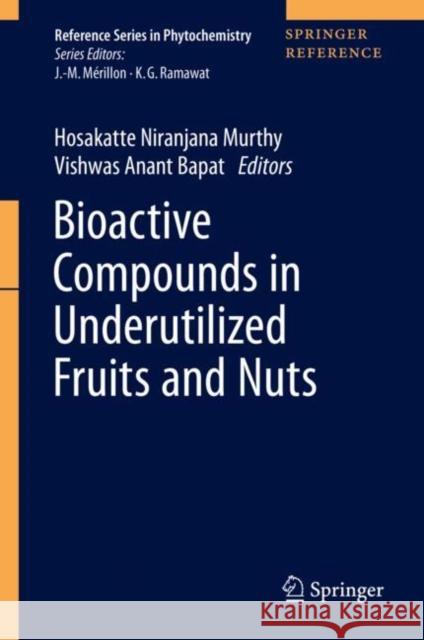Bioactive Compounds in Underutilized Fruits and Nuts » książka



Bioactive Compounds in Underutilized Fruits and Nuts
ISBN-13: 9783030301811 / Angielski / Twarda / 2020 / 665 str.
Bioactive Compounds in Underutilized Fruits and Nuts
ISBN-13: 9783030301811 / Angielski / Twarda / 2020 / 665 str.
(netto: 2690,06 VAT: 5%)
Najniższa cena z 30 dni: 2120,54
ok. 22 dni roboczych
Dostawa w 2026 r.
Darmowa dostawa!
Importance of Underutilized Fruits and Nuts;- Bioactive Compounds of Arid and Semiarid Fruits: Impact on Human Health;- Bioactive Compounds of Annona;- Bioactive Compounds of California Fan Palm (Washingtonia filifera (Linden ex André) H. Wendl. ex de Bary);- Bioactive Phytochemicals of Cape Gooseberry (Physalis peruviana L.);- Bioactive Compounds of Date Palm (Phoenix dactylifera L.);- Bioactive Compounds of Longkong Fruit (Lansium domesticum Corr.);- Bioactive Compounds of Loquat (Eribotrya japonica (Thunb.) L.);- Bioactive Compounds of Rambutan (Nephelium lappaceum L.);- Phytochemistry and Bioactivity of Solanum betaceum Cav. ;- Bioactive Compounds of Soursop (Annona muricata L.) Fruit;- Bioactive Compounds of Avocado (Persea americana Mill.);- Bioactive Compounds of the Brazil Nut (Bertholletia excelsa Bonpl.): Nutritional and Health Aspects;- Phytochemistry and Pharmacology of Mesua ferrea L.;- Bioactive Compounds of Tucuma (Astrocaryum aculeatum G. Mey.);- Therapeutic, Phytochemistry, and Pharmacology of Acorns (Quercus Nuts): A Review;- Bioactive Compounds in Baru Almond (Dipteryx alata Vogel): Nutritional Composition and Health Effects;- Bioactive Compounds of Chestnut (Castanea sativa Mill.);- Phytochemicals of Calophyllum Inophyllum;- Bioactive Compounds of Camu-Camu (Myrciaria dubia (Kunth) McVaugh);- Exploring Phytochemicals of Ficus carica L. (Fig);- Bioactive Compounds of Marking Nut (Semecarpus anacardium L.);- Bioactive Compounds of Pili (Canarium ovatum Engl.);- Bioactive Compounds of Red-Jambo Fruit (Syzygium malaccense (L.) Merr. & L.M. Perry);- Bioactive Compounds of Buriti Fruit (Mauritia flexuosa L.f.);- Bioactive Compounds from Cubiu Fruits (Solanum sessiliflorum Dunal);- Bioactive Compounds of Karonda (Carissa carandas L.);- Bioactive Compounds of Bael (Aegle marmelos (L.) Correa);- Bioactive Compounds of Salacia chinensis L;- Bioactive Compounds of Guava (Psidium guajava L.);- Bioactive Compounds of Plum Mango (Bouea microphylla Griffith);- Bioactive Compounds of Wood Apple (Limonia acidissima L.);- Bioactive Compounds of Drumstick (Moringa oleifera Lam.);- Bioactive Compounds from Gac (Momordica cochinchinensis Lour. Spreng);- Bioactive Compounds in Southern African Fruits;- Food Processing Waste: a Potential Source for Bioactive Compounds;-
Hosakatte Niranjana Murthy professor in Post-Graduate Department of Botany, Karnatak University, Dharwad, India, has obtained his Ph.D. degree from the same university. He has tremendous passion for research and academics. Since 1986, Prof. Murthy has served in various positions in the Post-Graduate Department of Botany, Karnatak University, Dharwad, India. Apart from his teaching experience of 33 years, he possesses extensive research experience in the area of plant biotechnology. Prof. Murthy has post-doctoral and collaborative research experience in many foreign research institutes. He worked at Biotechnology Division, Tata Energy Research Institute,New Delhi, India (1992); Crop Science Department, University of Guelph, Guelph, Canada (1993); Research Centre for the Development of Horticultural Technology, Chungbuk National University, Cheongju, South Korea (2000–2001, 2002, 2004, 2006–2007, 2013–2014); and Department of Biological Sciences, University of Nottingham, Nottingham, United Kingdom (2005–2006) as a post-doctoral fellow/visiting scientist. Prof. Murthy is the recipient of various prestigious fellowships including Biotechnology National Associate, Biotechnology Overseas Associate (awarded by Department of Biotechnology, Ministry of Science and Technology, Government of India), Brain Pool Fellowship (awarded by Korean Society of Science and Technology, South Korea), Visiting Fellowship (awarded by Korea Science and Engineering Foundation, South Korea), Commonwealth Post-doctoral Fellowship (awarded by Association of Commonwealth Universities, UK). He has successfully completed more than 15 research projects funded by various agencies and guided several Ph.D. students. Prof.Murthy has published more than 200 research articles in international peer reviewed journals with high impact factor. His research work has been cited more than 3600 times by fellow researchers and has H-index (Hirsch index) of 32 as recorded by Scopus.
Prof. Murthy has developed biotechnological methods for the production of pharmaceutically important secondary metabolites from cell and organ cultures of ginseng, Siberian ginseng, Echinacea, and St. John’s wort using large-scale bioreactors along with South Korean collaborators. His experimental investigations on the use of adventitious root cultures and bioreactor technologies for the production of biomass and secondarymetabolites have paved a way to commercialization of plant secondary metabolites. Various ginseng-based commercial products have been released and are currently available in market.
Vishwas Anant Bapat received his Ph.D. Degree in 1981 from the University of Mysore, Karnataka, India, and has worked at Bhabha Atomic Research Centre, Mumbai, India, for 36 years as a scientist. Post retirement, he joined Shivaji University, Kolhapur, India, as Emeritus Scientist CSIR, later Senior Scientist INSA, and is currently working as Honorary Scientist NASI. On the research front, Prof. Bapat has worked on basic and applied research which has paved way for the conceptual and practical development in plant biotechnology. Key themes and strategies established by him include micro propagation, rescue of endangered plants, somatic embryogenesis and synthetic seeds, induced mutations, protoplasts culture, molecular markers, transgenic plants, and plant secondary metabolites. The other frontier areas of his research are nano biotechnology, bioremediation of hazardous chemicals, and technology transfer to the users’ agencies. Prof. Bapat has worked at Max Planck Institute, Koln, Germany, for a year. He has published more than 200 research papers including several book chapters. Prof. Bapat has guided Ph.D. students, postdoc students, and is an active member of numerous research projects. He is a fellow of Maharashtra Academy of Sciences, India; Indian National Science Academy, India; and National Academy of Sciences, India.
1997-2025 DolnySlask.com Agencja Internetowa
KrainaKsiazek.PL - Księgarnia Internetowa









